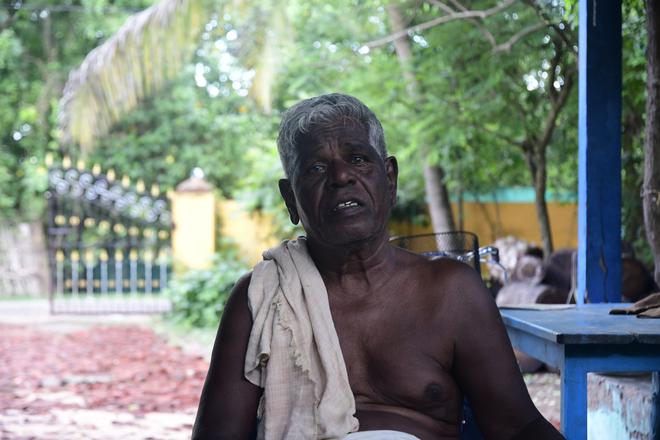
The wound on the thigh of G. Palanivel, just above the knee, that required 14 stitches has healed. However, even after 55 years, the scar of the semi-circular cut made with a sickle constantly reminds him of the spine-chilling night of December 25, 1968.
Mr. Palanivel, now 77, is the survivor of the gruesome massacre that took place in Keezhvenmani, a village then located in the composite Thanjavur district, in which 44 people – including 20 women and 19 children – were locked in a hut and burnt alive by landlords for rallying under the red flag and demanding a hike in wages. All victims were agricultural labourers.
“I managed to escape. But the henchmen of the landlord, Gopalakrishna Naidu, hacked my thigh with a sickle. I ran away, taking advantage of the pitch darkness, and hid in the paddy fields with some other workers,” recalled Mr. Palanivel, who was 22 then.
Next day, Mr. Palanivel was taken to hospital where the wound was closed with 14 stitches. “I also had six pellets in my body. They fired at me and the others with a gun meant for hunting egrets and other water birds. Though they were removed, the itch is still there,” said Mr. Palanivel, showing his ankle where the skin had turned rough because of allergy. Subsequently, he had spent six months and 19 days in the Thanjavur prison before being shifted to Tiruvarur.
Sitting beside Mr. Palanivel is T. Sethupathi, the younger brother of Ramaiah in whose hut the Scheduled Caste workers took refuge when they were surrounded by the landlord’s henchmen. The incident was made into a documentary, Ramaiahvin Kudisai (Ramaiah’s Hut), by Bharathi Krishnakumar. It is also the subject matter of Indira Parthasarathy’s award-winning novel Kuruthipunal.
Besides Ramaiah, his wife Papa, daughter Chandra, son Asaithampi and three-year-old child Vaskuki were charred to death.
U. Selvaraj, another survivor, lost his grandmother and aunt in the massacre. “The scene was strangely reminiscent of a cremation ground, not so much an ordinary crematorium where bodies seek their painless extinction but an eerie place where tender childhood, bashful youth and loving motherhood met their abrupt, cruel end in agony and despair,” wrote late Communist leader Mythily Sivaraman, the first outsider to enter Keezhvenmani, now part of the Nagapattinam district.
The shifting sands of Tamil Nadu’s politics were more pronounced in the composite Thanjavur region where Communists and the Dravidian movement gained ground. The paddy fields in the composite Thanjavur district were owned by a few landlord families. They meted out whipping and forceful drinking of cow dung mixed in water to workers who resisted their diktats. While the landlords remained largely with the Congress, the agriculture labourers, mobilised by the Communist leaders, including B. Srinivasa Rao, Manali Kandasami, Kathamuthu, G. Veeraiyan, K.R. Gnanasambandam, and Amirthalingam, raised a banner of protest and demanded higher wages.
Highest proportion
Ms. Sivaraman had noted that Thanjavur had the highest proportion of landless labourers – for every 10 cultivators, there were nine labourers in 1961.
The 1971 Census found that 41% of the rural population comprised landless labourers, while the State average was 29%. Thanjavur also had the highest percentage of Harijans among the landless. The landlords ruled the roost.“Tea stalls used to keep aluminum cups for the Dalits.... My brother was already cultivating the land of the local landlord and insisted that I take care of his cattle instead of going to school...I had no option,” recalled Mr. Palanivel.
It was the Communist movement that changed the fortunes of the Dalit farm workers in the region. But both the party and the workers had to pay a heavy price. “All that the workers demanded was just half-padi (measure) paddy more than what they were receiving as wages. But the landlords insisted that the Communist party flag be removed first and they join the Paddy Producers’ Association. The Dalit peasants, however, rejected the landlords’ demand,” recalled CPI(M) Politburo member G. Ramakrishnan.
Gopalakrishna Naidu, founder of the Nagapattinam Taluk Paddy Producers Association, representing the landlords, would send workers from outside for harvest whenever local agricultural labourers demanded higher wages and refused to work for the rates fixed by landlords. A series of confrontations and a few murders over the years culminated in the massacre at Keezhvenmani since the workers were under pressure to join the Paddy Producers’ Association.
On the day when the massacre happened, two peasant leaders – Muthusamy and Munian – were beaten up and locked in a house. The peasants went as a team and released them and it resulted in the killing of Pakkirisamy, an agent of the landlord. The retaliation started in the night.
“The landlords’ frustration, and inability to reconcile themselves to the Harijans’ new-found identity found expression on December 25, 1968, in Keezhvenmani,” says Ms. Sivaraman, whose writings were published as a book, Haunted by Fire, Essays on Caste, Class, Exploration and Emancipation.
Though the Sessions Court awarded them 10 years’ imprisonment, the High Court acquitted Gopalakrishna Naidu and others on the ground that those who committed the arson were unaware that 42 persons were inside the hut. Naidu was subsequently killed by members of Left parties.
Mr. Ramakrishnan said the massacre forced the government to appoint the Ganapathia Pillai Commission, which recommended enactment of Minimum Wages Act and it was implemented. It also recommended house pattas for Dalit peasants. As many as 1,80,000 families had benefited.
A memorial for the victims was set up in 1970 and the Communist parties continue to retain their ground though the Dravidian parties and their emergence as ruling parties continue to pose a challenge to them.
“Today, caste discrimination has come down drastically. We maintain a cordial relationship with the families of other communities and attend marriages and other functions. This is not possible [in places] where the Communist parties are not strong,” says Mr. Palanivel.







